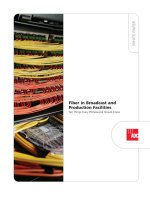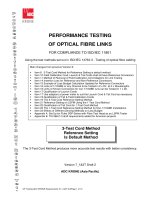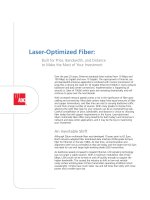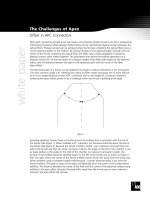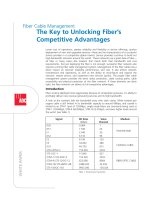Tài liệu ADC KRONE - Guide - Ethernet Cat Connectivity Selection docx
Bạn đang xem bản rút gọn của tài liệu. Xem và tải ngay bản đầy đủ của tài liệu tại đây (32.06 KB, 4 trang )
white paper
Ethernet Connectivity
Selection Tutorial
Category 5, 5e or 6? 110 punchdown, or RJ to RJ? T568A or T568B? Shielded or unshielded?
Will I choose the right Ethernet patch panel for my application? Will this choice work with future
applications? Am I getting the best overall value?
With all the choices you face as you design your network and select equipment, including avail-
able Ethernet patch panels, it’s easy to become confused and frustrated. Ultimately your choice of
Ethernet panels should fit the applications you plan to run. ADC wrote this short tutorial to guide
you through these decisions, to make them as painless as possible and offer you the best solution
for your network.
First, let’s ask a few key questions. Your answers will help guide you in the decision process. Next,
we will briefly discuss each of the most popular options available so you can draw conclusions based
on your network needs.
Discovery Questions
• What applications are you or do you plan to run on this network? 10/100Base-T? 1000Base-T?
• What type of network are you designing? Data center? Data backbone? LAN?
• Is the project a new network installation or addition to existing network?
• Is the installation being built to expand existing capacity with current data capabilities or is it
for new, faster data applications?
Answers to these questions will guide you to a particular cable type, a particular data patch panel,
and the means to terminate the cable into the patch panel — whether the terminations into the
patch panel involve “punchdown” cable terminations, pre-made telco-type multi-pair cable ends,
or standard RJ45 cable ends.
The general guidelines for network transmission capabilities segment the data network; data cen-
ter and data network backbone system applications require the highest level of transmission capa-
bilities, while feeds to work areas generally require a bit less. However, all network connectivity
should be designed with only the highest network engineering standards available.
Category 5, 5e, and 6 Cabling
The Telecommunications Industry Association (TIA) standards forming group consists of a variety
of industry experts including connectivity and cable manufacturers, distributors, installers, and end
customers. The TIA determines certain transmission characteristics that must be met to qualify a
cable for certain network applications.
Category 5 cabling is currently the most prevalent wiring in existing buildings. Electrical charac-
teristics defined by the TIA specify near end cross-talk (NEXT), attenuation, and return loss to 100
MHz. The TIA Technical Services Bulletin (TSB) 95 recommends additional criteria for far end cross-
talk (FEXT).
2
Category 5e is currently the minimum TIA recommended category of wiring for new installations.
Electrical characteristics for NEXT, FEXT, attenuation, and return loss are specified to 100 MHz. NEXT
performance is slightly better than category 5.
Category 6 is gaining popularity for new installations. Electrical characteristics for NEXT, FEXT, atten-
uation, and return loss are specified to 250 MHz. Improvements in all electrical parameters are part of
the higher TIA Category 6 standard.
Category 7 cabling is a developing standard as of this writing. The International Standards
Organization (ISO) is leading the standardization efforts for this new individually-shielded, overall-
shielded, 4-pair cable with transmission specifications referenced to 600MHz. The cable end interface
will probably be something other than the familiar RJ45 connector, mainly to differentiate the
Category 7 installation from existing lower-bandwidth infrastructure.
So, which should you use? There is quite a bit of misleading information in the industry on this sub-
ject, the biggest myth being that Category 6 is required to run Gigabit Ethernet over copper
(1000Base-T). Actually 1000Base-T was designed by the IEEE to run on Category 5. As long as the
Category 5 is installed according to TIA-568-B standards and meets the testing criteria in TIA TSB 95,
1000Base-T will perform satisfactorily on Category 5. However, as of this writing, the TIA recommends
Category 5e over Category 5 as the minimum cabling for new network infrastructure installations.
When do I use Category 6? Does the application standard (i.e., Gigabit Ethernet, 10G, etc.) specify
Category 6 as a minimal requirement? As of this writing, the TIA is making recommendations to the
IEEE 802.3ae and the 10 Gigabit Ethernet Alliance, who are currently working on 10 Gigabit cabling
systems, that any 10 Gigabit Ethernet designed to run on copper cabling use Category 6 because of
its improvement in signal to noise. The good news is that Category 6 is backward compatible and will
have no trouble running existing applications such as 10/100Base-T and 1000Base-T.
Cable Type Summary
The chart below summarizes the industry standard UTP cable types used in current networking instal-
lations.
In addition to the UTP cabling described above, you should understand the issues of cable shielding,
and stranded versus solid cable.
Shielded vs. Unshielded Twisted Pair
Unshielded twisted pair (UTP) cabling provides immunity to electromagnetic interference (EMI) with the
properties of the two conductors that make up a transmission pair being twisted together. When UTP
cabling encounters electrical interference, the noise crossing the twisted pairs is cancelled by the twists
in the cable (called “Common Mode Rejection”, a subject outside the scope of this paper).
Standard Category 5, 5e and 6 cables contain four unshielded twisted pairs of conductors. For
10BASE-T and 100BASE-TX applications, only two pairs are used, one for the transmit circuit and one
for receive circuit. For 1000BASE-T (Gigabit Ethernet) all four pairs are required.
The term “shielded twisted pair” cabling can be misleading. There are actually two methods of shield-
ing a twisted pair cable. Screened twisted pair cable (ScTP) provides an overall screen or metal foil
around the four pairs of conductors, but each individual twisted pair is unshielded. Shielded Twisted
Category Test Frequency 10/100BaseT 1000BaseT Future Applications Relative Cost
Cat 5 100 MHz Yes Yes No $
Cat 5e 100 MHz Yes Yes Maybe $
Cat 6 250 MHz Yes Yes Yes $$
Cat 7 600 MHz Yes Yes Yes $$$$
3
Pair cable (STP) has each individual pair shielded, plus an overall screen around the four individually
shielded pairs. This makes a very expensive and hard to install cable - the legacy token ring IBM Type
1 cable and Category 7 are examples of STP cable. STP cable requires metal end connectors and metal
jacks that bond the cable shield to earth ground to carry the interfering signals safely away from the
signal conducting pairs – failure to connect the cable shield to earth ground results in the shield cou-
pling the interfering noise to the conductors, providing very poor transmission performance. Most of
the world uses UTP cabling, with some exceptions located in a few countries in Europe.
Stranded vs. Solid Conductor Cable
Stranded cable is flexible and often used for patch panel jumpers and work area connections. Stranded
cabling is used for shorter patching applications for its flexible cable construction, but also exhibits
higher attenuation due to the smaller diameter conductors, and as such should not be used for long,
permanent installations. Solid conductor cable is used for the “horizontal” cable runs from the
telecommunications room to the work area wall outlet. The typical gauge for Category 5e cable is 24
AWG. Category 6 is 23 AWG - the larger conductor diameter improves attenuation characteristics and
signal-to-noise ratio versus the smaller conductor diameter of Category 5e.
Wiring Schemes, T568A vs. T568B
Wiring schemes also raise a variety of questions:
Q: What’s the difference between T568A and T568B?
A. The only difference is the positioning of the Green and Orange pairs of wires (see figure 1)
Figure 1
Typical RJ45 cable ends, T568A vs. T568B
Q: Is there a performance difference between T568A and T568B?
A: No. Both wiring schemes have to meet the same performance criteria.
Q: Why two schemes?
A: The reason is outside of the scope of this paper but it is related to old telephone legacy issues.
All you really need to know is that there are two schemes, and how to deal with them.
T568A T568B
Pair 3
Pair 1
Pair 4
Pair 2
Pair 2
Pair 1
Pair 4
Pair 3
ADC Telecommunications, Inc., P.O. Box 1101, Minneapolis, Minnesota USA 55440-1101
Specifications published here are current as of the date of publication of this document. Because we are continuously improving our products, ADC
reserves the right to change specifications without prior notice. At any time, you may verify product specifications by contacting our headquarters
office in Minneapolis. ADC Telecommunications, Inc. views its patent portfolio as an important corporate asset and vigorously enforces its patents.
Products or features contained herein may be covered by one or more U.S. or foreign patents. An Equal Opportunity Employer
1276553 02/04 Original © 2003 ADC Telecommunications, Inc. All Rights Reserved
Web Site: www.adc.com
From North America, Call Toll Free: 1-800-366-3891 • Outside of North America: +1-952-938-8080 Fax: +1-952-917-3237
For a listing of ADC’s global sales office locations, please refer to our web site.
The solution really is fairly simple: Just pick one wiring scheme and use it consistently throughout your
network. The only problem you would ever encounter would be if the two wiring schemes were acci-
dentally mixed in an installation. T568B is the predominate scheme in the United States; T568A is pop-
ular in Canada and in many other countries. The safest way to determine which to use is to check with
the network equipment provider to determine the predominant wiring scheme used in the equipment.
The reason for this check is quite simple: you can change the wiring scheme used in the network but
you cannot change the wiring scheme used in the network equipment.
Patch Panel Rear Termination Options
Popular choices for patch panel rear terminations include 110 Insulation Displacement Contact (IDC)
punchdown termination, and connectorized cable end terminations (RJ45 and RJ21X).
Many popular data patch panels are designed using 110 IDCs, requiring the manual punchdown ter-
mination of each individual wire. A typical 24-port panel requires 192 individual punchdown termina-
tions. With this many manual terminations, installation mistakes are common, including incorrect wire
mapping (cross-wiring), opens, shorts, and excessive untwisting of the wire pairs. Terminating the
“horizontal” cabling from the work areas in the telecommunications room typically uses 110 IDC
punchdown panels.
For patch-panel-to-patch-panel connections in a data center or telecommunications room, pretermi-
nated cable assemblies and connectorized patch panels can improve installation time and connectivi-
ty success. A preconnectorized solution dramatically decreases the assembly time and increases the
quality of the termination, as the contact points are typically gold-on-gold with high contact forces.
Preconnectorized solutions do require up-front planning — the distances between panels must be
determined so the correct cable assembly length can be ordered.
RJ45-to-RJ45 and RJ45-to-RJ21X panels are the two most popular preconnectorized systems. The
RJ21X, also known as 50-pin telco or 25-pair Amphenol
®
connectors, is popular because six 4-pair
Ethernet (1000BaseT) or twelve 2-pair Ethernet (10/100BaseT) circuits can be terminated at one time
on a panel using the correct multi-pair cable assembly.
ADC Solutions
Listed below are some of ADC’s panel solutions that meet the recommendations above. Please con-
tact ADC’s Technical Assistance Center for more information on these or any other solutions.
Catalog Number Category Wiring Scheme Rear Termination Applications Supported
ADCPP24505 5e Universal T568A/B RJ45 All
ADCPP245800BTEL 5e T568B RJ21X All
ADCPP245100TEL 5 10/100Base-T Specific RJ21X 10/100Base-T
ADCPP245EB110 5e T568B 110 All
ADCPP245EA110 5e T568A 110 All
ADCPP24C6 6 Universal T568A/B 110 All



